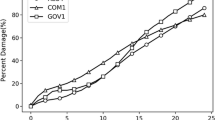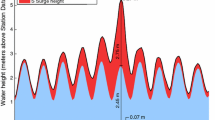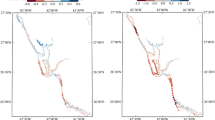Abstract
Reliable and robust methods of extreme value-based hurricane surge prediction, such as the joint probability method (JPM), are critical in the coastal engineering profession. The JPM has become the preferred surge hazard assessment method in the USA; however, it has a high computational cost: One location can require hundreds of simulated storms and more than ten thousand computational hours to complete. Optimal sampling methods that use physics-based surge response functions (SRFs) can reduce the required number of simulations. This study extends the development of SRFs to bay interior locations at Panama City, Florida. Mean SRF root-mean-square errors for open coast and bay interior locations were 0.34 and 0.37 m, respectively, comparable with ADCIRC errors. Average uncertainty increases from open coast, and bay SRFs were 10 and 12 %, respectively. Long-term climate trends, such as rising sea levels, introduce nonstationarity into the simulated and historical surge datasets. A common approach to estimating total flood elevations is to take the sum of projected sea-level rise (SLR) and present day surge (static approach); however, this does not account for dynamic SLR effects on surge generation. This study demonstrates that SLR has a significant dynamic effect on surge in the Panama City area, and that total flood elevations, with respect to changes in SLR, are poorly characterized as static increases. A simple adjustment relating total flood elevation to present day conditions is proposed. Uncertainty contributions from these SLR adjustments are shown to be reasonable for surge hazard assessments.







Similar content being viewed by others
Abbreviations
- EVA:
-
Extreme value analysis
- JPM:
-
Joint probability method
- OS:
-
Optimal sampling
- JPM-OS:
-
Joint probability method with optimal sampling
- SRF:
-
Surge response function
- SLR:
-
Sea-level rise
- MSL:
-
Mean sea level
- SST:
-
Sea surface temperature
- IPCC:
-
Intergovernmental Panel on Climate Change
- NOAA:
-
National Oceanic and Atmospheric Administration
- LCLU:
-
Land cover-land use
- PDF:
-
Probability density function
- RMS:
-
Root-mean-square
- a 1, a 2 :
-
Gumbel coefficients
- Z :
-
Total maximum flood elevation
- T Z :
-
Total maximum flood elevation return period
- x :
-
Location of interest
- ϕ :
-
SRF model term
- c p :
-
Hurricane central pressure
- R p :
-
Hurricane radius of maximum winds
- v f :
-
Hurricane forward velocity
- θ :
-
Hurricane track angle
- x 0 :
-
Hurricane landfall position
- \(x^{{\prime }}\) :
-
Dimensionless alongshore parameter
- \(\zeta^{{\prime }}\) :
-
Dimensionless surge parameter
- ζ :
-
Peak surge elevation
- λ(x 0):
-
Ratio between relative maximum peak surge location and R p
- c :
-
Dimensionless regional scaling constant
- L 30 :
-
Cross-shore distance from shoreline to 30-m bathymetric contour, at x 0
- L 30-ref :
-
Threshold value of L 30
- R thres :
-
Threshold value of R p
- a 1, a 2, b 1, b 2 :
-
Dimensionless scaling coefficients
- m 2, α, β :
-
Dimensionless scaling coefficients
- ∆p :
-
Ambient pressure and hurricane central pressure difference
- ∆p max :
-
Maximum theoretical hurricane intensity (Tonkin et al. 2000)
- [R p/L 30]ref :
-
Maximum value of R p/L 30
- γ 0 :
-
Reference specific weight of water
- ɛ z :
-
Epistemic uncertainty
- ɛ tide :
-
Tide model uncertainty
- ɛ model :
-
Hydrodynamic and wind model uncertainty
- ɛ waves :
-
Wave model uncertainty
- ɛ wind :
-
Wind model uncertainty
- ɛ residual :
-
Residual uncertainty
- ɛ SRF :
-
SRF uncertainty
- ɛ SRF :
-
SLR model uncertainty
- μ :
-
Mean of normal distribution
- σ 2 :
-
Variance of normal distribution
- Z SLR :
-
Total flood elevation at projected SLR, relative to present day MSL
- Z 0 :
-
Present day total flood elevation
- k, l :
-
Location-dependent fit coefficients
References
Bilskie MV, Hagen SC, Medeiros SC, Passeri DL (2014) Dynamics of sea level rise and coastal flooding on a changing landscape. Geophys Res Lett 41:927–934
Booij N, Ris RC, Holthuijsen LH (1999) A third-generation wave model for coastal regions: 1. Model description and validation. J Geophys Res 104(C4):7649–7666
Condon AJ, Sheng YP (2012) Optimal storm generation for evaluation of the storm surge inundation threat. Ocean Eng 43:13–22
Fallah MH, Sharma JN, Yang CY (1976) Simulation model for storm surge probabilities. Coast Eng Proc 1(15):934–940
Hagen SC, Bacopoulos P (2012) Coastal flooding in Florida’s big bend region with application to sea level rise based on synthetic storm analysis. Terr Atmos Ocean Sci 23(5):481–500
Irish JL, Resio DT (2013) Method for estimating future hurricane flood probabilities and associated uncertainty. J Waterw Port Coast ASCE 139(2):126–134
Irish JL, Resio DT, Cialone MA (2009) A surge response function approach to coastal hazard assessment. Part 2: quantification of spatial attributes of response functions. Nat Hazards 51(1):183–205
Irish JL, Frey AE, Rosati JD, Olivera F, Dunkin LM, Kaihatu JM, Ferreira CM, Edge BL (2010) Potential implications of global warming and barrier island degradation on future hurricane inundation, property damages, and population impacted. Ocean Coast Manag 53:645–657
Irish JL, Sleath A, Cialone MA, Knutson TR, Jensen RE (2013) Simulations of Hurricane Katrina (2005) under sea level and climate conditions for 1900. Clim Change 122(4):635–649
Lin N, Emanuel K, Oppenheimer M, Vanmarcke E (2012) Physically based assessment of hurricane surge threat under climate change. Nat Clim Change 2(6):462–467
Liu D, Pang L, Fu G, Shi H, Fan W (2006) Joint probability analysis of hurricane Katrina 2005, vol 3. In: Proceeding of international offshore and polar engineering conference, San Francisco, USA, pp 74–80
Mousavi ME, Irish JL, Frey AE, Olivera F, Edge BL (2011) Global warming and hurricanes: the potential impact of hurricane intensification and sea level rise on coastal flooding. Clim Change 104(3–4):575–597
Niedoroda AW, Resio DT, Toro GR, Divoky D, Das HS, Reed CW (2010) Analysis of the coastal Mississippi storm surge hazard. Ocean Eng 37(1):82–90
Parris A et al (2012) Global sea level rise scenarios for the United States National Climate Assessment. NOAA Technical Report OAR CPO-1. National Oceanic and Atmospheric Administration, Silver Spring
Passeri DL, Hagen SC, Bilskie MV, Medeiros SC (2015) On the significance of incorporating shoreline changes for evaluating coastal hydrodynamics under sea level rise scenarios. Nat Hazards 75(2):1599–1617. doi:10.1007/s11069-014-1386-y
Pfeffer WT, Harper JT, O’Neel S (2008) Kinematic constraints on glacier contributions to 21st-century sea-level rise. Science 321(5894):1340–1343
Rahmstorf S (2007) A semi-empirical approach to projecting future sea-level rise. Science 315(5810):368–370
Resio DT, Boc SJ, Borgman L, Cardone V, Cox A, Dally WR et al (2007) White paper on estimating hurricane inundation probabilities. US Army Corps of Engineers Engineer Research and Development Center, Vicksburg
Resio DT, Irish J, Cialone M (2009) A surge response function approach to coastal hazard assessment—part 1: basic concepts. Nat Hazards 51(1):163–182
Resio DT, Irish JL, Westerink JJ, Powell NJ (2013) The effect of uncertainty on estimates of hurricane surge hazards. Nat Hazards 66(3):1443–1459
Smith JM, Cialone MA, Wamsley TV, McAlpin TO (2010) Potential impact of sea level rise on coastal surges in southeast Louisiana. Ocean Eng 37(1):37–47
Solomon S (ed) (2007) Climate change 2007-the physical science basis: working group I contribution to the fourth assessment report of the IPCC, vol 4. Cambridge University Press
Song YK, Irish JL, Udoh IE (2012) Regional attributes of hurricane surge response functions for hazard assessment. Nat Hazards 64(2):1475–1490
Thompson EF, Cardone VJ (1996) Practical modeling of hurricane surface wind fields. J Waterw Port Coast ASCE 122(4):195–205
Tonkin H, Holland GJ, Holbrook N, Henderson-Sellers A (2000) An evaluation of the thermodynamic estimates of climatological maximum potential tropical cyclone intensity. Mon Weather Rev 135:746–764
Toro GR, Niedoroda AW, Reed CW, Divoky D (2010) Quadrature-based approach for the efficient evaluation of surge hazard. Ocean Eng 37(1):114–124
University of Central Florida (2011) Flood insurance study: Florida Panhandle and Alabama, model validation. Report. Federal Emergency Management Agency, Philadelphia, PA
Westerink JJ, Luettich RA, Feyen JC, Atkinson JH, Dawson C, Roberts HJ, Powell MD, Dunion JP, Kubatko EJ, Pourtaheri H (2008) A basin-to channel-scale unstructured grid hurricane storm surge model applied to southern Louisiana. Mon Weather Rev 136(3):833–864
Woodruff JD, Irish JL, Camargo SJ (2013) Coastal flooding by tropical cyclones and sea-level rise. Nature 504(7478):44–52
Yang CY, Parisi AM, Gaither WS (1970) Statistical prediction of hurricane storm surge. Coast Eng Proc 1(12):2011–2030
Yin J, Overpeck JT, Griffies SM, Hu A, Russell JL, Stouffer RJ (2011) Different magnitudes of projected subsurface ocean warming around Greenland and Antarctica. Nat Geosci 4(8):524–528
Acknowledgments
This material is based on the work supported by the National Sea Grant College Program of the U.S. Department of Commerce’s National Oceanic and Atmospheric Administration (Grant No. NA10OAR4170099. The views expressed here do not necessarily reflect the views of this organization. The STOKES ARCC (Advanced Research Computing Center) at the University of Central Florida provided computational resources for storm surge simulations (System. Administrators: P. Wiegand and G. Martin). The authors wish to thank Dr. James, M. Kaihatu, and Patrick W. McLaughlin, for their contributions to this work.
Author information
Authors and Affiliations
Corresponding author
Appendix
Appendix
The joint probability density function, f, in Eq. 1 for the JPM-OS is defined as:
where f = probability density functions; a 1, a 2 = Gumbel coefficients; μ = mean of normal distribution; σ 2 = variance of normal distribution; () indicates the parameter is a function of the variable in parentheses.
Rights and permissions
About this article
Cite this article
Taylor, N.R., Irish, J.L., Udoh, I.E. et al. Development and uncertainty quantification of hurricane surge response functions for hazard assessment in coastal bays. Nat Hazards 77, 1103–1123 (2015). https://doi.org/10.1007/s11069-015-1646-5
Received:
Accepted:
Published:
Issue Date:
DOI: https://doi.org/10.1007/s11069-015-1646-5




